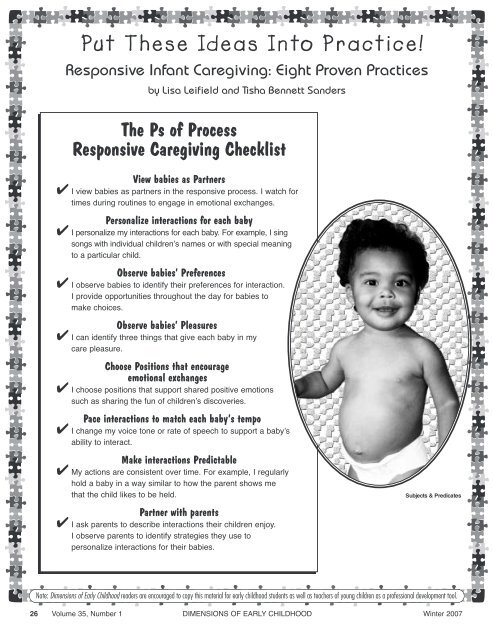Dimensions of Early Childhood - Southern Early Childhood ...
Dimensions of Early Childhood - Southern Early Childhood ...
Dimensions of Early Childhood - Southern Early Childhood ...
Create successful ePaper yourself
Turn your PDF publications into a flip-book with our unique Google optimized e-Paper software.
Put These Ideas Into Practice!<br />
Responsive Infant Caregiving: Eight Proven Practices<br />
by Lisa Leifield and Tisha Bennett Sanders<br />
The Ps <strong>of</strong> Process<br />
Responsive Caregiving Checklist<br />
View babies as Partners<br />
✔ I view babies as partners in the responsive process. I watch for<br />
times during routines to engage in emotional exchanges.<br />
Personalize interactions for each baby<br />
✔ I personalize my interactions for each baby. For example, I sing<br />
songs with individual childrenʼs names or with special meaning<br />
to a particular child.<br />
Observe babies’ Preferences<br />
✔ I observe babies to identify their preferences for interaction.<br />
I provide opportunities throughout the day for babies to<br />
make choices.<br />
Observe babies’ Pleasures<br />
✔ I can identify three things that give each baby in my<br />
care pleasure.<br />
Choose Positions that encourage<br />
emotional exchanges<br />
✔ I choose positions that support shared positive emotions<br />
such as sharing the fun <strong>of</strong> childrenʼs discoveries.<br />
Pace interactions to match each baby’s tempo<br />
✔ I change my voice tone or rate <strong>of</strong> speech to support a babyʼs<br />
ability to interact.<br />
Make interactions Predictable<br />
✔ My actions are consistent over time. For example, I regularly<br />
hold a baby in a way similar to how the parent shows me<br />
that the child likes to be held.<br />
Partner with parents<br />
✔ I ask parents to describe interactions their children enjoy.<br />
I observe parents to identify strategies they use to<br />
personalize interactions for their babies.<br />
Subjects & Predicates<br />
Note: <strong>Dimensions</strong> <strong>of</strong> <strong>Early</strong> <strong>Childhood</strong> readers are encouraged to copy this material for early childhood students as well as teachers <strong>of</strong> young children as a pr<strong>of</strong>essional development tool.<br />
26 Volume 35, Number 1 DIMENSIONS OF EARLY CHILDHOOD Winter 2007

















